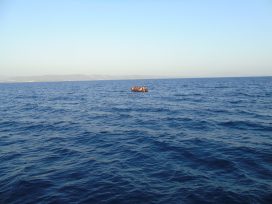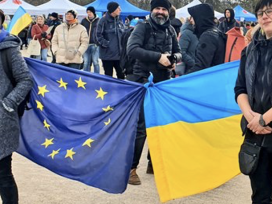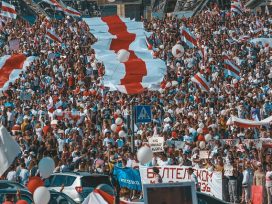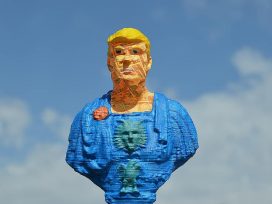Any reference to postmodernity brings to mind such notions as the multiplicity of opinions, eclecticism, open-mindedness and open-endedness, the lack of clear-cut definitions, relativity, and a host of various other features, which pose quite a challenge to those of a classical or modernist mindset. The list can be further extended to include other notable principles: the subversion of the existing order, the reconciliation of incompatibles and, most importantly, deconstruction, which targets fixed truths, meanings, values and criteria, such as identity and other modern foundations of meaningfulness.
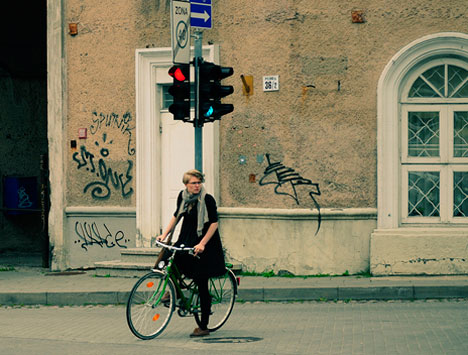
Everyday life in Lithuania. Photo: Pavel Hadzinski. Source:Flickr
It is necessary to underscore that all of this exists not only in the heads and texts of contemporary philosophers and artists, but is also clearly manifest in our everyday life and influences individual self-consciousness, communications, cultures, economics, politics and much more. Not only our way of thinking but also our contemporary reality are becoming progressively postmodern, and new terms keep appearing to denote one or another feature of it, for instance, hybrid war, postmodern totalitarianism, etc.
Lithuanian identity has also found itself in the domain of postmodernity, both on the level of ideas and in terms of lived reality, and it is worth considering how the aforementioned facets affect, alter, and will continue to alter Lithuanian self-consciousness; what we gain and lose in the process; what is objectively inevitable and what depends on our wilful choice, on our self-perception, willpower, desires, wishes, or the lack thereof, and on other subjective motives.
All this applies to both my young and middle-aged compatriots, particularly those who grew up and matured under conditions of democracy and openness after Lithuania regained its independence in 1990. Their thinking and tastes have been influenced not only by postmodernist attitudes, but also by the increasingly intense intrusion of electronic technologies, consumerist culture, and other factors, which the older generations had not encountered at all.
But then of course, not all elderly or young people are alike. The influence of the post-communist transformations of society (or those of “mature post-communism”, to borrow Almantas Samalavicius’s phrase) should not be disregarded either. A lot of things amalgamate in this domain, and it is difficult to pinpoint what exactly influences what. Therefore, the concept of postmodernity should be understood as a very broad and inclusive one, and it is interesting to consider what kind of individual a postmodern Lithuanian could be, one whose features are emerging right now and who, in the future, will be the dominant type of fellow citizen.
To my mind, writing about postmodern things can be “postmodern” too, that is, neither particularly clear, nor particularly coherent or developed. Still, I am of a modern mindset and thus feel the need to explain how I understand individual identity.
On the one hand, identity is acquired in a seemingly unconscious way as it is defined, “granted”, by the family, origins, heritage, environment and traditions. On the other, the individual chooses, creates, and develops his/her own identity. Stepping outside one’s subjectivity, s/he “steps outside him/herself”, relates to, identifies with external, real, or imagined manifestations of existence. Their range is wide and includes profession, career, family, historical figures, fictional characters and, ultimately, values, ideas and beliefs. One or another form of identification is part of individual growth and the process of identity formation.
The modern conceptualization of individual identity essentially accommodates both what is “obtained” objectively and what is developed independently. Even though the subjective part of identity is not “tied” to the objective one, the balance between the two is, nonetheless, more or less stable. The individual understands him/herself as such, identifies with, without necessarily becoming, what his/her real-life situation and social roles connected with the family, profession, etc, bear witness to. The modern individual can be said to be integrated from within: a stable, “predictable” person, capable of using his/her will to achieve the goals s/he has set, aware of who s/he is and is not, what s/he wants or does not. One should also keep in mind such ambiguous traits as conservativeness, inertness and closedness.
The postmodern individual can be defined as one characterized by a weak and unstable relationship between the two aforementioned sides, objective and subjective. S/he creates her/his identity freely, without being limited by or respectful of her/his origins and traditions, but by seeking for “points of attachment” in much broader spaces, not only in reality but also in virtual reality. The life of individuals with a flexible, multiple identity is a constant self-search, albeit not always successful, because not everyone is able to avoid mistakes and find his/her “real self.” But then, the modern individual’s identity is not necessarily always successful either.
Discussing the identity of the modern Lithuanian, some objective criteria should be singled out as particularly important. With regard to social origins and status, a modern Lithuanian is typically a farmer (less frequently, a landlord or an urban citizen), a member of the intelligentsia, which originated from farmers, or, according to his calling or choice, a priest, medical doctor, lawyer, an official, or, less frequently, some other professional. Religiously, he is a Catholic, a Lutheran, an agnostic or an atheist. When it comes to family status, he is a member of a traditional family and of heterosexual orientation. He is also a conscious and patriotic citizen of his country, once it has become independent. Identifying with one’s country and, during the years of occupation, with the idea of it, which one seeks to realize, is a very important aspect of modern Lithuanian identity.
Certainly, it was precisely such Lithuanians who made possible the signing of the act proclaiming the restoration of the independent state of Lithuania on 16 February 1918. During the years following World War II, such Lithuanians joined the resistance movement and died for the freedom of their homeland. Arguably, the Lithuanians saw the second restoration of the country’s independence, on 11 March 1990, as modern (in the aforementioned sense of the word) members of the nation, even if significantly afflicted by Soviet erosion. Twenty-five years after independence, it is obvious that the attachment that fellow citizens once felt to Lithuania has considerably weakened. Judging by the prevalent opinions and moods, and drawing on recent research, many identify with the country only in formal terms, do not value this connection, and do not pride themselves in being Lithuania’s citizens but, rather, feel estranged from it, although they still see themselves as Lithuanians.
The reasons for this indifference are a separate topic, but such an attitude to one’s homeland is partially compensated for by the identification with a region (“I’m a Samogitian”), on the condition that regionalism does not become a political issue. That regional identity is preferred to state identity is ostensibly a feature of postmodernist self-consciousness. The opposite can be observed when one identifies with the European Union (“I’m a European”) rather than with one’s own state, all of which helps explain why the significance of nation-states is growing increasingly weak.
There is also a vision of a regionalist European Union, which has attracted supporters in various countries. According to it, the constituent parts of the EU should be regions as opposed to nation-states, because some of the former historically predate modern states and are thus are more culturally authentic. Such an attitude is as much a step towards postmodernity as identifying with the entire wide world rather than to some clearly defined place. Those who do not have a state or a region to call home look at the world with the eyes of a cosmopolitan.
A negligent attitude toward one’s country is somewhat compensated for by identifying with the nation (“I’m Lithuanian, and I want to be Lithuanian”), which suggests that the idea of national unity remains alive, but also that most Lithuanians are more comfortable with seeing themselves as an ethno-cultural community rather than as a nation-state. It is certainly important to identify with a nation; for Lithuanians, the significance of this connection was immense during the years of the occupations, but now that we are citizens of an independent state, it is far from sufficient. Leaning towards ethnic self-consciousness, however, is also a clear feature of postmodern identity.
A deconstructive approach reveals how weak and unstable national feelings are when rooted solely in ethno-cultural identification and how they fail to provide adequate interpersonal ties. The feelings of unity within a nation decrease particularly rapidly when one chooses to emigrate. Contemporary Lithuanians, for instance, are not particularly happy to encounter a compatriot on the streets of London or in the orange groves of Spain; more often than not, unfortunately, they have grounds for that.
Emigration has become an integral aspect of our existence in the Lithuania of the twenty-first century. This shows that Lithuanians are not as inert with regard to the land of their forefathers, nor as connected to it as was traditionally thought. Their tendency towards nomadism, which has so suddenly come to light, is an obvious sign of postmodern identity.
The emigrants are very different when it comes to the issue in question. Some are acutely disappointed with their homeland and cannot wait to discard anything that is reminiscent of it. They do not think of one day returning and therefore naturally fall outside the scope of my considerations. However, the majority of those who depart do not hasten to clarify their position regarding their possible return. Still others, despite their new circumstances, think and feel as if they have never left Lithuania; they would even state that they “love their homeland even more ardently”, from afar. Some do indeed prove their love through deeds: they maintain close relations, act as go-betweens, or return with new knowledge, experience and money.
Obviously, emigrants need to adjust to the new environment, and to develop necessary habits and skills, while simultaneously relinquishing a certain number of those brought from home. The first issue to arise is that of social identity. Few manage to escape the doubling of roles: a teacher in Lithuania turns into a nurse for the elderly in Chicago; a graduate with an MA in law in Lithuania becomes a barman in London, etc. Which role to identify with though, the present, factual one or that of the past? Who to see oneself as? It is an obvious turn towards the postmodern lack of clear-cut definitions.
National identity transforms in a similar way. An emigrant’s Lithuanian identity acquires certain American features in the United States, Irish ones in Ireland, or Spanish ones in Spain. “Hybrid national identity” develops: Lithuanian American, Lithuanian Canadian, etc. Time tends to work to the benefit of the second part of the compound. For instance, when asked who he considers himself to be, a Lithuanian American from the generation of the post-war emigrants, now residing in Vilnius, answered without a flinch, “I’m American.”
Both national and social hybridity should be attributed to the postmodern self-consciousness, and it should be acknowledged that the number of “postmodern Lithuanians” is increasing. It is they who can and should be on the forefront of the “global Lithuanian” project, helping enhance communications between Lithuanian diasporas in different countries and strengthening their ties with Lithuania. In a world in which the importance of distances is constantly decreasing, this would be similar to the distant learning projects that proclaim the university to be there, where the student is. Drawing a parallel, one could say that Lithuania, too, can be anywhere there are Lithuanians willing to maintain their national identity, and capable of doing so, from a distance.
This could prove less productive than expected, but certain losses are inevitable. A student in a distance learning programme acquires knowledge often without ever hearing the live speech of a professor, or being exposed to the influence of the professor’s personality; in a similar way, a “global” compatriot does not feel and is not directly affected by his/her homeland.
The instability and non-finiteness of social and professional identity, as well as the doubling of national identity, should be recognized as attributes of the postmodern individual. Quite possibly, the future of our country will lean towards a more or less narrow version of “global Lithuania”, in which a significant number of citizens will be marked by “hybrid” and “flexible” identities.
When thinking about the present, one should not forget the past. Historical memory is a significant constituent of individual self-consciousness, as is the evaluation of past events and of their participants, and expressions of respect or disdain for them. I am not going to speak about the recent past, with which many still feel connected through live memories. Of great importance to an individual’s identity is also the distant and very distant past. Historical narratives offer a range of characters that could enrich both the individual and national self-consciousness of contemporary Lithuanians.
Lithuanians are often said to have descended from serfs; this supposedly explains such features as their lack of self-esteem and “that damned submissiveness”, but also abundant passivity, greed, jealousy and other features said to characterize the poor. Serfdom did indeed significantly scar the national character. The immense popularity of the image of the Pensive Christ in Lithuanian folk art is particularly suggestive of the national character. Some can use such a self-image to justify the lack of higher aspirations or self-humiliation. This is an uninspiring and even destructive form of identification.
Times have changed; serfs turned into free farmers, among whom there were not only patient ploughmen, but also educated people devoted to cultural work; in the nineteenth century, it was they who disobeyed the imposition of Russian-only education and Tsar Alexander II’s ban on the printing and importing of printed material that used the Latin alphabet; they who smuggled Lithuanian books into the country. They represent the modern Lithuanian type. For the most part, it is people of this type who nurtured and sustained Lithuanian culture in the twentieth century as well.
Moreover, besides the aforementioned serfs, we see colourful figures of the landed gentry, who ruled their large and small estates, oppressed their serfs, and quarrelled with each other, but also founded cultural centres and stood up for their homeland in armed combat when necessary, thereby giving birth to the heroic image of the Lithuanian warrior. Thus the Lithuanian gentry can offer contemporary fellow citizens historically justified examples to identify with. Nonetheless, obtaining documents which prove the noble origins of one’s ancestors is not enough; one has to invest effort in living up to the image, to behave properly and to deserve respect. However, if an individual’s “nature” clashes with this, one can resort to a less noble but no less popular image of the gentry as libertines and debauchees.
Of course, this is far from an exhaustive description of the Lithuanian gentry. They were also people of double identity, who could be both lituanus and polonus, frequently both embodied in the same person. The gentry take us back to the times of the Polish-Lithuanian Commonwealth (1569-1795), which have not yet been entirely relegated to the past. This is evident in the arguments of some educated individuals who maintain that Lithuania’s historical mission was to continue the tradition of the Commonwealth; according to them, the act of independence of 1918 was a digression, undertaken “by mistake”. This “Jagiellonian” tradition of statehood, called thus in celebration of the Jagiellonian dynasty, founded by the Grand Duke of Lithuanian Jogaila through his marriage to Queen Jadwiga of Poland in 1386, can certainly become a source of patriotism and strength for contemporary Lithuanians, especially in the context of the prospective integration with the European Union.
This vision of Lithuanian statehood is much broader than the modern one. It opens a possibility for contemporary Lithuanians to identify with one or another tradition, but also allows them not to identify with any at all. At this point I stop my historical retrospection, even though much could be said about the Lithuania of the Grand Dukes or about Baltic pagan culture. However, let us return to the present times.
All that has been discussed here speaks of endless possibilities of identification, open for individuals who depart from the standards of modernity. Numerous and diverse forms of postmodern identity are possible, all comprised of disparate and often even incompatible elements, whether national, social, cultural, religious or historical, etc. Any of them can become the core of individual identity. What is particularly important is the role granted to national feelings, and whether they become the “centre” which coordinates all other elements.
This, however, is a matter of free individual choice. I say “free” because choice can be strongly influenced by traditions, public opinion, responsibilities and other determining factors. True, no one is ever fully independent from these, but postmodernist thinking, in contrast to its modernist counterpart, is nonetheless markedly more free and independent. On the other hand, it avoids engaging in projects that require long-term responsibility. The modern individual, in the meantime, who cherishes traditional values, can set long-term goals, which s/he does not abandon even if the expected results take a lot of time and consistent effort to materialize; for example, such projects could entail programmes of civil or some other form of education.
These remarks, I suppose, do not give grounds to judge postmodernist thinking one-sidedly, let alone negatively. The features that define this kind of thinking and related lifestyles are undoubtedly valuable; features such as openness, maintaining an independent stance, being susceptible to novelties and tolerant of otherness, and the ability to change and adjust to new surroundings. But it is not difficult to see other features as well, such as the lack of stable foundations and clear criteria, relativism and moral indifference, inconsistency and the lack of resilience to destructive influences. Whether postmodernist thinking is creative and constructive or passive, indifferent, and prone to self-destruction is a result of the balance between the aforementioned features; in other words, it is important which of them get to dominate.
The major problem is how the typology of Lithuanian identity might develop in the future, starting from today. To be more precise, how can we find the necessary balance between modernity and postmodernity, these two distinct ways of thinking, was of life? The best possible expectation would be such: the Lithuanians of tomorrow should accommodate the good qualities of both, and these qualities should complement one another. Moreover, it is certainly possible to accommodate them. Postmodernity’s lack of clear-cut definitions and finiteness is an important condition for the two orientations to avoid clashing with one another and for postmodernist thinking to be open to certain precise definitions that modernity offers. The openness of postmodernist thinking is also favourable to the emigrants of earlier generations, who no longer speak the language of their parents and grandparents, but who have not forgotten their roots; or to those who consider themselves Lithuanians historically or according to some other criterion.
To conclude, some more specific comments. With reality turning increasingly postmodern, the social roles performed by our fellow citizens are going to become more and more flexible and diverse as a result of the mobility of individuals and workplaces on both local, European and even global levels. Therefore, the nation’s openness to the world is also going to increase, and the number of Lithuanians who will study, work, vacation, and, alas, commit crimes abroad will rise. Openness is a serious premise to secure the balance between those who leave and those who return, especially when the latter grow in numbers.
Identity, be it individual or national, is a unique relationship between what is granted one by his or her origin and what he or she creates. What is granted should be adequately understood and cherished to prevent it being lost. The postmodern identity favours self-creation and self-development much more than does the modern one, and the range of what to choose and who to identify with is significantly broader, reaching global levels.
Therefore, it is safe to predict that the Lithuanian identity will continue developing in the direction of multiculturalism, maybe even multi-confessionalism, traces of which can already be seen, for instance, in the processions of people reciting Hare Krishna on the streets of our cities. Such instances can be dismissed as marginal cases, but it clearly shows that exotic cultures are entering Lithuania, and some of our fellow citizens are adjusting their various elements to suit their own identities. Undoubtedly, such “invasions” will only increase, which begs a question as to whether they will not overwhelm the Lithuanian ethno-cultural tradition. This tradition is the unique heritage of our nation, but if we want it to be appealing and engaging, traditional methods of preservation are not enough. We need innovative interpretations, contemporary and more universal attitudes and criteria, which would help assess the influence of other cultures and reveal the value of our own cultural heritage, on a larger scale than we are used to.
Such renewal is necessary to be able to offer Lithuanians following postmodernist trends as many diverse points of attachment as possible, through which to boost and develop their national self-consciousness.
According to Marshal McLuhan, we live in times where the only constant is being in a hurry. It is thus safe to predict that young people will continue to hurry to create their success stories, which will then become the foundational elements of their identity. Active citizenship, which correlates with a particular attitude towards one’s country, will probably be overwhelmed by consumerist principles. Hardly anyone will care about looking to the past to find inspiration for one’s identity, and probably only historians and political scientists will still be discussing which stage in Lithuanian history is to be considered foundational for its statehood.




